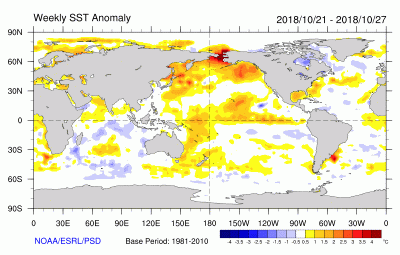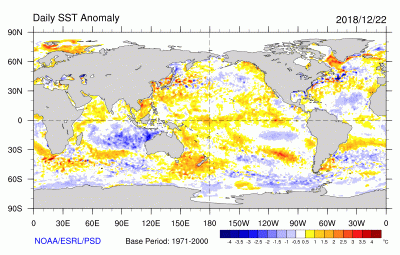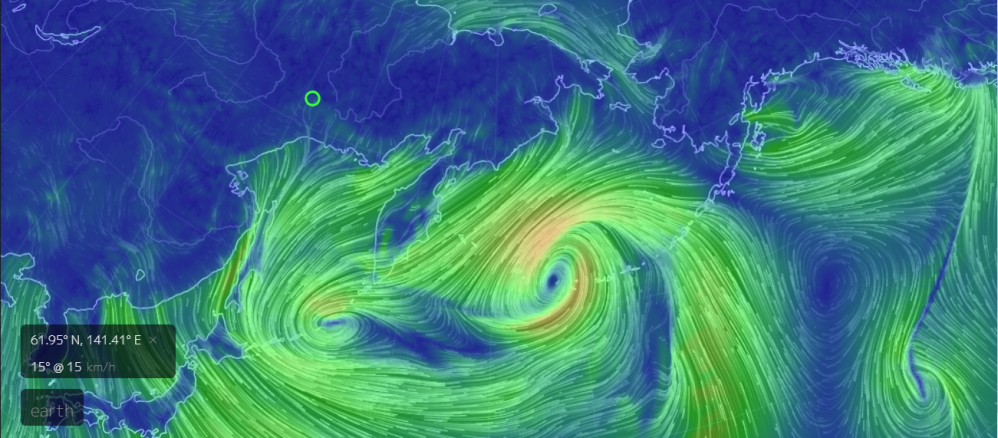Remarkable growth of ice in Bering Sea has been observed over the last three weeks as shown above. The extent went from 57k km2 to 424k km2 during that period, and is presently 94% of the maximum Bering ice extent in March 2018. To put this event in context, note that Bering 2018 maximum was low and pulled down the overall Arctic extent in March. For example, 2017 Bering maximum was 725k km2 compared to 2018 max of 451k km2, or a difference of 48%. We will be watching to see how much will be added in the coming 3 months.
Note also that Chukchi north of Bering completed freezing over on day 352, December 18, 2018. We can also see that Okhotsk on the left was freezing at the same rate as Bering, but added no new ice in the last week.
The Bering ice recovery coincides with the demise of the North Pacific "Cold Blob" as reported by Cliff Mass on Dec. 24 Sad News: No More BLOB Excerpts in italics with my bolds.
Starting the autumn, the BLOB was relatively weak. To illustrate, here is the sea surface temperature anomaly (difference from normal) for the end of October–as much as 2-3C warmer than normal! This was associated with an area of persistent high pressure over the northeast Pacific.
But compare that situation to two days ago. The BLOB is essentially gone, with an area of cooler than normal water developing. Only immediately along the coast is the water temperature slightly above normal.
What killed the BLOB? Persistent storminess over the northeast Pacific, something that is no surprise to the storm-battered residents of the Pacific Northwest.
Outlook from Dr. Judah Cohen Dec. 24, 2018 at Arctic Oscillation and Polar Vortex Analysis and Forecasts
In conclusion there is still much uncertainty with the predicted PV disruption and the longer it takes for the PV disruption to unfold the longer it will take for any impacts to reach the surface. And I would argue it makes very important differences on the sensible weather whether the PV splits, and if it splits the duration and the location of the sister vortices. But a robust PV split increases the likelihood of severe winter weather in the near term and more so long term for both the Eastern US and Europe. Also expect ongoing model forecast volatility until the circulation anomalies associated with the PV disruption reaches the tropopause as we argue in my most recent paper Cohen et al. 2018.
One last thing that I feel may play an important role on the NH circulation are sea ice anomalies. For months I have been anticipating that the greatest sea ice anomalies this winter will be in the Barents-Kara Seas. That is quite apparent in today's Figure 15. Typically blocking is focused across Greenland following a PV disruption. But abundant sea ice near Greenland and the lack of sea ice in the Barents-Kara Seas may help focus future high latitude blocking closer to Europe this winter. Strong Scandinavian/Barents-Kara Seas blocking may favor an eastward shift of the cold air across Europe. Cold air may drain into Eastern Europe but be blocked from Western Europe.
Finally, today from nullschool we can see the North Pacific twin gyres at work:
Summary
Several Alaskan kids are in the group suing the US government over fears of Arctic warming. It's looking like they may get relief from nature before it can come from the courts.
from Climate Change Skeptic Blogs via hj on Inoreader http://bit.ly/2SpGeOw




No comments:
Post a Comment